#cochin history
Explore tagged Tumblr posts
Photo

(via Kochikkar by Bony Thomas - A Brief History of Kochi's Diversity)
The book Kochikkar (Kochiites in English translation) by Bony Thomas is an exploration into the lives, customs, religious practices, traditions, languages, beliefs, and narratives of tens of ethno-religious communities residing in Cochin (Kochi), which by the earlier definition comprises the twin neighbourhoods of Fort Cochin and Mattancherry occupying an area of roughly four and a half square kilometers. Despite having been born here and growing up here, I only had a superficial understanding of these diverse communities, partly because I lacked the curiosity and inquisitiveness of an outsider. The pages of this book helped me have delve deeper into their lives. For example, though I knew the area where Konkanis lived, I used to be puzzled why they had at least three temples within an area of a radius of merely fifty metres. Now I do know; though I perceive all Konkanis as one, they are actually divided into sub communities based on caste and live their separate lives, a fact practically invisible to the observer. I also gained clarity about the different Jewish communities, namely the White (Paradesi) Jews and Black Jews, and their synagogues, and also how the Black Jews are again of two different groups, Kadavumbhagam and Thekkumbhagam, and how they acquired these names. Among the many other things I learned from the book is information like D V Dev, the famous perfume merchant, is Marathi and the popular vegetarian restaurant Sri Krishna Cafe belongs to Tulu Brahmins, and many such who’s whos. The various communities in Kochi today include descendants of foreigners such as the Portuguese, English, Dutch, Jews, people believed to be the descendants of Arabs from Yemen and Iraq, and those who migrated here from other parts of India o... (Read full text on booksperience.org)
#books#reading#booksperience#bony thomas#cochin#cochin history#fort cochin#fort kochi history#history of cochin#history of kochi#kerala#kerala history#kochi#kochi history#kochiites#kochikkar#malayalam books#mattancherry#non-fiction#old cochin#old kochi
0 notes
Text

Cochin Jewish ketuba, the certificate of the marriage of Haim Hallegua to Miriam Koder, in 1923 - witnesses Abraham Cohen and Reuben Hallegua.
photo from India’s Jewish Heritage: Ritual, Art, & Life-Cycle, courtesy of Samuel H. Hallegua, author of the chapter, "The Marriage Customs of the Jewish Community of Cochin."
#judaism#jewish#jumblr#jewblr#art history#jewish art history#jewish history#ketubah#art#cochin#cochin judaism#jewish art
287 notes
·
View notes
Photo

Cochineal is a brilliant red dye extracted from the crushed bodies of parasitic insects which prey on cacti in the warmer parts of the Americas. The dye was an important part of trade in ancient Mesoamerica and South America and throughout the colonial era when its use spread worldwide. Even today, cochineal continues to be used in foodstuffs and cosmetics.
34 notes
·
View notes
Text

Charles-Nicolas Cochin (French, 1715-1790) Funeral for Marie-Thérèse of Spain, Dauphine of France, in the Church of Nôtre Dame, Paris, on November 24, 1746, ca. 1746 The Cleveland Museum of Art
As an official draftsman to the king, Charles-Nicolas Cochin was responsible for documenting royal events, festivities, and ceremonies. When the Spanish princess Marie-Thérèse, wife of Louis XV’s eldest son, died in childbirth, she was given two lavish funerals: one at the Church of Saint Denis, and another, represented in this drawing, at Notre Dame in Paris. Cochin’s drawing shows how the interior of the gothic cathedral was theatrically redecorated in the current rococo style. Beneath the majestic canopy in the center of the nave, an ornate arched structure, a baldequin, contains the princess’s coffin.
#Charles Nicolas Cochin#french art#french#european history#art history#western civilization#art#european art#fine art#classical art#europe#european#fine arts#mediterranean#europa#southern europe#notre dame#paris#1700s#marie therese of spain#spain#spanish#classic art#drawing#history#historic#france#the west#western europe#hispanic
40 notes
·
View notes
Photo
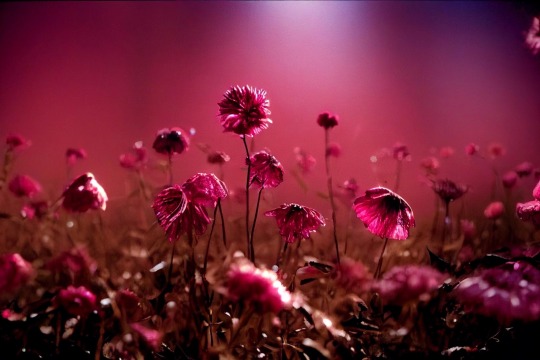
PANTONE 18-1750 Viva Magenta !
Courtesy of Pantone Institute
#art#desin#colors#pantone#magenta#nature#2023#18-1750#viva#crimson red#shade#cochineal#dye#insect#history
67 notes
·
View notes
Photo

3 juin 1783 : mort de Cochin, fondateur de l’hôpital éponyme ➽ http://bit.ly/Jean-Denis-Cochin Issu d’une famille parisienne ancienne et puissante, dont la lignée remonte au XIIIe siècle, il annonça d’abord du goût pour l’état ecclésiastique, et voulut à seize ans entrer chez les chartreux
#CeJourLà#3Juin#Cochin#ecclésiastique#hôpital#hospice#pauvres#biographie#histoire#france#history#passé#past#français#french#news#événement#newsfromthepast
2 notes
·
View notes
Text



i got to paint using ground cochineal insects today!
i meant to get a picture of the paints, but those four cups had lemon juice, water, baking soda, and borax added, respectively. the different pHs change the color of the cochineal powder from reddish-orange (acidic pH) to crimson (neutral pH) to beet-pink and deep purple (basic pH)
#cochineal#natural dyes#peabody museum of archeology and ethnology#harvard peabody museum#harvard museum of natural history#harvard museums of science and culture#hmsc
4 notes
·
View notes
Text
I think I'm missing something about the assertion that "Star of David" is a poor and/or erroneous translation. It's not a literal translation, no, and saying it's a translation with objectionable enough connotations that you'd rather people used a different translation, yeah that makes sense. (In your opinion, should I switch to saying "Shield of David" or "Magen David"? Though I expect I'll repeatedly have to describe the shape or reference the more familiar name in order to un-confuse other non-Jewish people either way.)
But saying it's in error because "magen" doesn't mean "star" sounds to me like saying "coccinelle" is an erroneous translation of "Marienkäfer", because the one name refers to its appearance and the other only to its cultural association. And I have a feeling there's something wrong with that comparison, but I'm not sure what?
No Jewish symbol is more misunderstood than the Magen David, "The Star of David." A thread on the actual connection between the Magen David & Jewish magic:

Its magical origins are obscured by the English phrase, "The Star of David," which is a poor translation of Magen David. Magen = "shield." It is a symbol of a shield, not a star. Nowhere in Jewish literature do we find the phrase "kochav David." It is the "Shield of David."
Before the modern era, we most commonly find the Magen David in amulets. Since the role of an amulet is to provide protection, and a shield is a sign of protection, they are common in Jewish amulets.
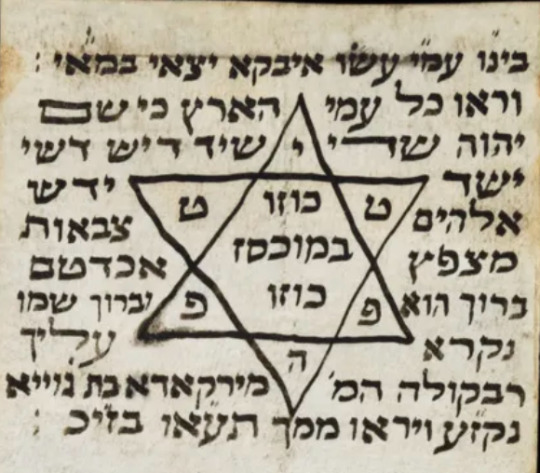
For instance, since a Mezuzah is a home amulet, medieval scribes would often add the "Shield of David" along with names of angels [in the boxes on the left column] to boost its protective powers. Like angels who bestow protection, so does the shield.

In recent articles, Moshe Idel has shown that Nehemiah ben Shlomo ha-Navi, a medieval Jewish mystic, claimed that David's shield was inscribed with Divine names. It was the magic of these "shielding" names that protected him in battle, not his military power.
For Kabbalists, the following verse shows David's reliance on magical, Divine names in battle: "David replied to the Philistine, 'You come against me with sword and spear and javelin; but I come against you in the name of the Yah of Hosts.'" [1 Sam. 17:45]
One magical name became especially associated with the Shield of David, the name AGLA. Abraham Saba (1440-1508), even claims that AGLA is called Magen David.

This association is likely due to the kabbalistic claim that AGLA is an acronym for the liturgical line, "ata gibor l'olam Adonai," which appears right after a reference to Magen Abraham. Hence this magical name became linked to the Magen, the shield.

By the early-modern period, the Magen David often appears in amulets with the name AGLA written in it (in various styles). The most common use of these amulets was to extinguish urban wild-fires.

This type of amulet became so popular in 17th-18th C. Germany (among Jews & Christians), that Lutheran theologians, who were extremely anti-magic, had to polemicize against the use of such amulets.

At exactly the same time (early 17th C.), Jews begin to be forced to wear the Magen David as a Jewish ID. While Jews had to wear ID badges since the Lateran Council of 1215, those were commonly a yellow wheel, and never a Magen David.
This is the earliest depiction of a Jew wearing one, from the early 17th century.

While there is no explicit evidence of such, it is likely that, at least in Ashkenaz, the Magen David became associated with Jews at this time because of its prevalence in popular Jewish amulets. To be a Jew was to have access to protective magic.
For instance, Wilhelm Schickard, a Lutheran theologian, in his work Tarich (1628, Tübingen), critiques the Jews for this: "The shield of David is the very thing which the most superstitious Jewish nation believes to be strong even against fires."

The Nazis, ostensibly, reversed this association. The Shield of David became a symbol for those bodies that are unworthy of protection.

When the founders of the State of Israel chose the Magen David as the national symbol, they were likely oblivious to this long history. But they could have done worse than choosing a Jewish symbol of protection that is other than military power.

It is unfortunate that right at time of the Holocaust and the founding of the State of Israel, the phrase "Shield of David"—with all its magical history—became overshadowed by the erroneous phrase, "Star of David."

The Magen David does not need to be a symbol of Israeli military power. For much longer it was associated with Jewish protective magic—a protection that comes not from swords & tanks, but from the Divine.

#judaism#lost in translation#thank you for the fascinating history of magic lesson#(cochineal is a vivid red dye made from beetles)#(the 'lady' in 'ladybug' is also a reference to mary mother of jesus)
361 notes
·
View notes
Photo
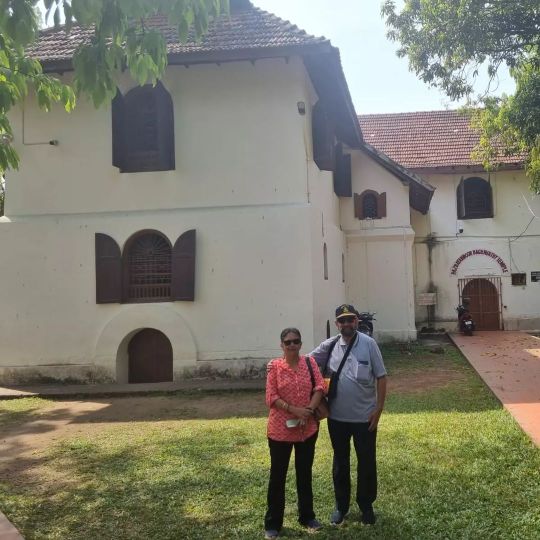
With "Better Half" at Dutch Palace (Mattanchery Palace) Kochi (Cochin) #lawrenceschool #lovedale #classof1971 #reunion #kerala #kochi #cochin #dutch #mattanchery #palace #heritage #history #tour #tourism (at Dutch Palace) https://www.instagram.com/p/CnUPngjyDvN/?igshid=NGJjMDIxMWI=
#lawrenceschool#lovedale#classof1971#reunion#kerala#kochi#cochin#dutch#mattanchery#palace#heritage#history#tour#tourism
0 notes
Text
Full disclosure: I am an Ashkenazi Jew with pale skin, so I encourage any Mizrahim who see this post to comment their own views if they disagree or want to add something that I may have missed.
“Jews are white!”
I truly marvel sometimes at how many levels of stupidity are displayed in just three words. First off, the statement is wrong on the face of it—biological races don’t exist, even if the social construct of it does.
But secondly, when leftists say this, they’re completely ignorant of the 3000 years of our history which very much says we are in no way shape or form members of the “white” social category. We are white people, despite the word “ghettos” having originated as a term for the impoverished Jewish segregated areas in European cities? Nazis didn’t invent ghettos, by the way, the first mention of them dates to the early 16th century to refer to a Jewish ghetto in an Italian city state.
American Jews suffer the supermajority of religious based hate crimes in the United States, despite making up like 2% of the total population. We are having to put armed guards outside our synagogues. A quarter of hiring managers don’t want to employ Jewish people—and that’s just how many admit to that. Not a century ago, we were literally murdered for not being white enough. And now goy Americans want to come in, glance at Israel, and announce we’re white colonizers?
This whole discussion doesn’t even begin to touch on the rich history of the Mizrahim and Beta Israel and the Bene Israel and the Cochin Jews and the Kaifeng Jews. Left wing antisemites will only mention Ethiopian Jews and Mizrahim to say that they’re discriminated against by the evil White Jews in power. They ascribe no agency to them—they just infantilize Jews of Color to being two dimensional victims of evil Ashkenazi Jews.
But Israel doesn’t fit neatly into this Americanized narrative of white oppressors against brown natives. Do Mizrahim and other Jews with brown skin—who make up the majority of the population—experience racism in Israel? Yes, of course. There was a full civil rights movement in Israel over it—look up the Israeli Black Panthers. But the way their experiences are only trotted out by left wingers to score points against Israel and then hushed away again is obscene. And anyway, even Ashkenazi Jews aren’t white either—Europe has made it clear to us, over and over again, that we are not white.
In short, no, we aren’t white. Not the Jews who pass as white, nor those of us who don’t.
#anti zionisim#leftist antisemitism#antisemitism#jumblr#jewish#israel#pro israel#judaism#dont even get me started on the “colonialism” aspect of the claim#That might be its own post in the future
744 notes
·
View notes
Text
British ships carrying plants and seeds from around the world arrived in Botany Bay on January 20 1788. This story is overshadowed by convict ships and Royal Navy vessels, but the cargo on board also had a lasting impact. Colonists, convicts and Indigenous Australians were all affected [...]. Some of these plants [...] were food sources [...]. Others were attempts to expand the British Empire. Could the new territory be exploited as a tropical plantation? In the parliamentary debate over destinations for convict transportation [considering potential locations for sending prisoners], Sir Joseph Banks and James Matra, both members of James Cook’s 1770 expedition [to the South Pacific], spruiked the potential of the new colony as an extension of the empire. Matra claimed the colony was “fitted for production” of “sugar-cane, tea, coffee, silk, cotton, indigo and tobacco”. Banks claimed Botany Bay was an “advantageous” site, with fertile soil [...].
Two plants carried by the First Fleet stand out as examples of botanical imperialism: prickly pear cactus (Opuntia) and sugarcane.
Banks, as head of the Royal Society of London [and as a close adviser to King George, and also as a plant-collecting botanist who turned the Royal Botanic Gardens at Kew in London into the world's leading botanical garden], selected these species as experiments to compete with European trade rivals. His goal was to break a Spanish monopoly in producing fabric dye and to expand British cultivation of sugar outside the West Indies.
Prickly pear cactus was imported because it is the preferred food of the cochineal insect.
Dried cochineal were crushed to make a vibrant, colourfast scarlet dye for textiles. Discovered in the New World by Spanish colonists, cochineal replaced kermes, another insect that had provided red dye since antiquity. Cochineal dye was ten times stronger than kermes or vegetable dyes.
From cardinals’ capes to British officers’ red coats, cochineal was a product for elite consumers signifying power, wealth and prestige.
New Spain, based in Mexico, had a monopoly on cochineal. Banks wanted to break the stranglehold on the scarlet dye by establishing production in New South Wales.
Plants infested with the precious insects were imported from Brazil in 1788. The project soon failed when the cochineal died, but the cacti survived. Colonists used cacti as natural fences and drought-resistant animal fodder.
Without insects to feed on them the plants spread, uncontrolled, to cover more than 60 million acres of eastern Australia by the 1920s. Poison, crushing and fire failed to stop the cactus. [...] Opuntia cacti remain an environmental hazard. [...] The roots of these early imperial projects are deeply embedded in Australian culture and history, with an enduring legacy.
---
All text above by: Garritt C. Van Dyk. "The botanical imperialism of weeds and crops: how alien plant species on the First Fleet changed Australia". The Conversation. 25 January 2024. [Some paragraph breaks/contractions added by me. Italicized text within brackets added by me for clarity and context.
437 notes
·
View notes
Text
hi hi hi!!! i’m not a natural dye expert by any means but i have experience working with it and i LOVE yapping about natural dye and historical fashion so. this post is really buzzing around my brain. i'm so so sorry for the absolutely incoherent rant i'm about to subject you to. (obviously this is just me and my experiences with dye processes talking. again. not the expert.)
(under a read more because good god i'm just yapping away here.)
first off, can i throw another contender in the ring for what color is Irene's Color™?? consider. indigo!! indigo is a natural dye that gives a beautiful blue, very deep and very rich. it's perfect for irene's hood-cloak-thing. HOWEVER. assuming your ru'an is based off of europe, you run into a similar-ish problem with tyrian purple, in that it is probably inaccessible to the average person---it would probably be imported into ru'an. perhaps from tu'la, which would have very interesting implications as to the relationship between tu'la and ru'an, and perceptions of the ru'anians who use indigo, especially after the tu'la invasion should you keep that in your rewrite. (maybe it could be a compromise between woad and tyrian purple?? perhaps??)
and that brings me to another thing!! what dye plants grow in ru'an and where? because that is a very important question that affects what colors your characters have access to. you can absolutely have naturally dyed greens and pinks. that is a thing that CAN exist with natural dye---i have seen it and i have done it---but it is dependent on what plants exist and where they're growing, like the indigo plant that i've mentioned.
assuming, again, that ru'an = europe. they would have access to madder (red) and weld (yellow---very bright yellow). disclaimer, my experience with naturally dyed green is with indigo. i've never worked with woad before. BUT. in theory. you should be able to dye something in weld and then dye it again in woad to get green. it's a slightly different process with indigo but that particular dye may or may not even be available in metelli anyways, so it doesn't really matter.
although. tangent about green in medieval-and-renaissance-ish europe. it was a wealthy people color, as you have to essentially dye the material twice when using natural dye. it was a way to flaunt your wealth without breaking sumptuary laws, which were established because the nobility really didn't like the new money tradesmen now being able to afford to "dress above their station" aka dress like the nobility. (i could go on about sumptuary laws but they essentially limited who could wear what and how much of a given material someone could use. like silk---you can only wear so much silk in your outfit if you aren't noble or whatever.) of course you don't have to use sumptuary laws, but i do think the implications of laurance (and cadenza) wearing green in this context would be fascinating.
okay so. about my claim that you can get naturally dyed pink. abandon all hopes of, like, hot pink at the door. BUT. a super light percentage of madder will give you, like, different shades of salmon pink. super pretty!! (you can find a picture of these pinks here https://blog.bindandfold.com/?p=570.)
see, when you dye something, the amount of time you have it in the dye bath doesn't typically matter? all that really matters is that you give the dye enough time to bond to the fiber you're dying, which is typically an hour (if you take out your fiber before the dye has enough time to bond to it, your color will fade. i have made this mistake. major bummer). what really matters is the WOF---the weight of fiber, or the percentage of dye material compared to the weight of the material you want dyed.
basically i would put less madder in my dye bath if i was trying to make pink, and more madder if i was trying to make a solid red, but both dye baths would need to sit for an hour to be colorfast and not fade.
also!! exhaust baths!! another way to get a lighter color (like pink)!! see, sometimes when you have a dye bath, there will still be dye particles leftover after you've run your first bath and taken your material out. you can (usually) still use this dye. you just put new fiber into it, and bam. we call this an exhaust bath---because the dye is "exhausted" . exhaust baths are always going to be lighter than the first bath, since they had less dye than the one that preceeded them. so long as the remaining dye particles have enough time to bond with the fiber, an exhuast bath should be just as colorfast as the first try. i've been able to get like, two or three dye baths out of the same pot of dye before. it works.
okay. i think that's all that i have in my brain. also i have definitely yapped on long enough. hope this was helpful!! good luck with your rewrite!!👍👍
when i’m trying to use a more plausible color scheme for everyone in my MCD rewrite (since it’s going to be set in a more underdeveloped time period, a lot of colors are going to be expensive/hard to find) and can’t decide what colors to give certain people 😭
im obviously gonna keep some of the original colors in the beginning (like Lord Burt wearing red because of its significance as a powerful color), but keep everyone’s else’s mostly plain. for example Nana won’t be an explosion of pink (although it will remain her favorite color), Aphmau won’t be wearing purple as often (the most common variation of the color was tyrian purple which took a very extensive amount of labor to make even one gram of the pigment. that, as well as the color being reserved for royalty), and Laurance won’t have as many green articles of clothing in the section of my rewrite portraying season two (the emerald green pigment was made from arsenic, which made it not only extremely toxic to produce but to wear as well as the skin would absorb the poison)
(i’m still debating about Dante and Garroth with their blue tones because it was a more common color amongst the poor people and was made with cheap, low quality dye, but Louis IX and Henry VIII started wearing it with other nobles and it became a color of high standing so…)
now this is also where I also come to a standstill because of these colors and what they used to represent. each Divine Warrior will have a color associated with them, which is where part of their symbolism will come from. however, I’m stuck on what color to give Irene
there’s a very brief clip somewhere I can’t remember when it appeared, but Irene was wearing a black two piece that seemed to be torn. I imagine this being something like her “first” outfit in the world so i’m not too worried about that one, but I’m more concerned about the one she wears when she’s portrayed
we see Irene wearing two cloaks from what I remember (my memory is garbage and I have yet to reach that far in anything). one of her cloaks was royal blue and the other is a lilac purple. the lilac purple would be a more difficult hue to achieve in the time period i’m reaching for, so either way i’m going to make the purple into a deeper shade.
i’m having such a war in my head about which color to choose for her, though. because both colors could signify who she is and i’m honestly debating just having different people give her different colors but I don’t know
on one hand, tyrian purple was a color reserved for royalty. using it could be used to show the high regard in which people in Ru’aun placed her. it could be used to signify their desire to have Irene rule as queen over the region before she diminished the monarchy and developed the Lord system instead. however, this color was made from a tiring process that required extensive amount of labor for barely anything to show the effort, and I feel as though the way to obtain the color doesn’t represent Irene the Matron
on the other hand, I feel as though a deeper blue pigment would be a better match. blue was original worn by peasants but the steady popularity it gained with nobility made it a more expensive and luxurious color for people that could afford it, as I previously said. this color I feel would fit better with her character to show that Irene came from humble beginnings and was put on a pedestal after her efforts for peace and becoming Lord of Scaleswind (which would be equal to blue becoming a color of nobility). the only problem with the blue is that the dye used by the peasants was low quality made from the woad plant that (from what i’ve seen) was dyed much lighter compared to the royal blue i’m talking about. i don’t know, maybe she got an upgrade at some point…
(can you tell i love the history behind colors)
(also if anyone has any other impactful information concerning colors please let me know i also actually love learning about it)
(and greatest apologies guys this is basically a yap post it has very little significance to anything)
#hopefully this made sense and my tone isn't like. obnoxious or anything.#anyways i love love love to yap about fiber processes and historical fashion and worldbuilding so this was extremely fun#i also still have my dye samples and my notes from my fashion history class so like. open invitation to ask me questions about this#kind of thing!! i can probably share some pictures of specific dye colors and materials that i've mentioned too if that would be helpful#also there totally is another way to get purple naturally without overdying or w/ tyrian purple if you're interested. cochineal my beloved.#throw a bunch of little bugs in a dye bath and they make this ruddy warm purple color. it's gorgeous. they're native to south america thoug#so probably not something available in medieval europe. but still!! very pretty.#a really good resource for natural dye information is maiwa---they're the company that my department buys all of their natural dyes from#they have more articles on their website about this sort of thing.#also i can't really vouch for her as i've literally just stumbled onto her but margaret byrd on yt might also be a good person to check out#at least when it comes to what material you might be able to get dye from.
28 notes
·
View notes
Text

Learning chicken breed history is like. It starts with the cochin. It's the cochin all the way down. Like every asiatic chicken breed is basically genetically a derivative of the cochin and where did other regions without junglefowl source their first chickens? Asia.
The Wikipedia page for Cochins says "The Cochin is a breed of large domestic chicken. It derives from large feather-legged chickens brought from China to Europe and North America in the 1840s and 1850s"
Those large chickens are who we can thank for most modern chicken breeds. They WERE cochins but poultry standards weren't like how they are now. People took those birds and selected for ones with foot feathers and other ones without. Then you get people selecting for different comb,body types, feathering, ect.
It's cochins it's all cochins.
80 notes
·
View notes
Text
audiobooks i have ready to listen to while i weave, i'm not sure how far i'll get through the list this week but this is my queue:
- the jakarta method by vincent bevins (re-listening, already halfway through)
- open veins of latin america by eduardo galleano
- a perfect red by amy butler greenfield (the history of cochineal dye and its role in western imperialism in latin america)
- the northwest is our mother by jean teillet (the history of the métis nation)
54 notes
·
View notes
Text
Red, White & Royal Blue Rebind


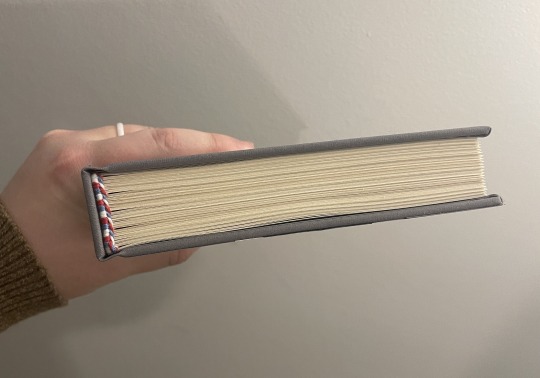
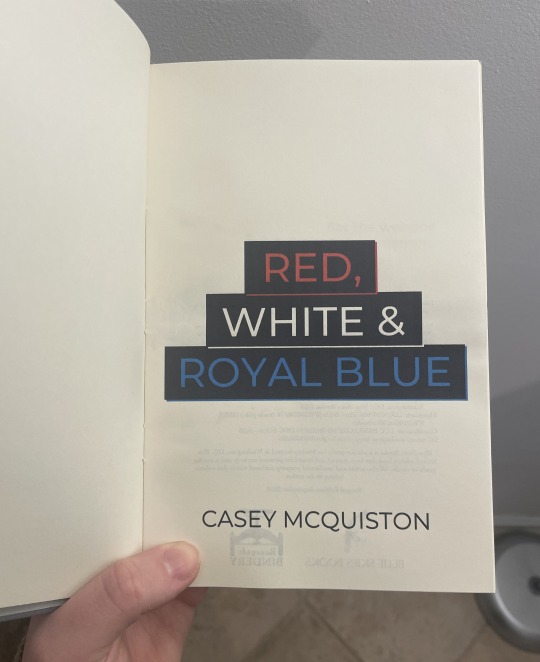


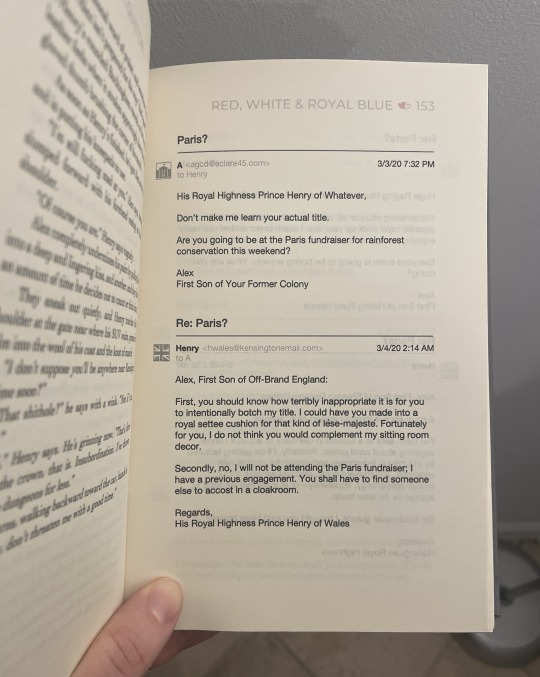

[ID: Eight pictures of a hand-bound rebind of the book "Red, White & Royal Blue." The first shows the cover, which has been bound in light gray bookcloth and is decorated to look like a suit with a union jack tie. There are two cardstock buttons, one that says "Vote Claremont" and the other that says "History, huh?" On the right side, the title "Red, White and Royal Blue" is painted on in red, white, and blue paint respectively. On the left side, the author name "Casey McQuiston" is painted on in white paint. The second shows the spine, covered also in gray bookcloth. It has the title "Red, White and Royal Blue" painted on in red, white, and blue paint respectively and the author name "Casey McQuiston" painted on in white paint. The third shows the book from the top so the headbands, sewn with red, white, and blue thread, can be seen. The fourth shows the title page of the book, which has the title "Red, White and Royal Blue" in red, white, and blue ink respectively, as well as the author name "Casey McQuiston" beneath it. The fifth shows the colophon page (left) and dedication page (right). The colophon has details about the book, as well as the binder logo for Blue Skies Books (a bluejay) and the logo for Renegade Publishing (a bookpress). The dedication page says, "For the weirdos and the dreamers" in a sans serif font above a black and white drawing of a reflective lake with pine trees around it. The sixth shows a chapter header page, which has a gray skyline that merges the skylines of DC and London across the top of it. The word "One" is in all caps in white on the lefthand side of the skyline, and body text is beneath it in a serif font. The seventh shows the inside of the book, drawing attention to the formatting of the emails throughout the book. The emails include icons for both Henry and Alex, email addresses, timestamps, and subjects. The eighth shows the inside of the book, drawing attention to the red, white, and blue heart page divider and the handwriting fonts used within the regular body text for certain words. /End ID]
When the Red, White and Royal Blue movie came out last year, I rediscovered my love for this book and these characters and just had to do a rebind of it! This is a full rebind, so I've done the typeset myself as well as the cover. I had a delightful time coming up with the cover design (I imagine this is modeled after a theoretical Alex suit, though it could be Henry's as well!), and I had an especially fun time doing the typeset. There are so many fun formatting elements in this story, and it was great getting to put my own spin on them.
Logistics-wise, this bind uses Lumeiere fabric paint and a Silhouette-cut stencil for the words, Silhouette-cut cardstock for the decorative elements, handmade cotton bookcloth for the cover, cotton embroidery thread for the endbands, and regular Hammermill cream paper for the textblock. (Once I've saved up for it, I'm looking forward to getting some short-grain textblock paper! This is still long grain.) The body font is Cochin and the title font is Montserrat.
And finally: my bind versus my trade paperback copy!

[ID: A picture of the hand-bound version of "Red, White and Royal Blue" from above held next to the mass-produced paperback version of the same book. They are made in different styles with different color schemes, but both have a fun and slightly whimsical appearance to them. /End ID]
180 notes
·
View notes
Text
The baby in the oven bit is probably propaganda but the rest is accurate. Hamas did kill babies, there's just no independent verification of a baby being burned in an oven.
The rest of this is true. Every other claim in here about Hamas & in general is true. It's only the baby being cooked in oven part that's probably misinfo. And really, you don't need the extra mile for propaganda, when just killing babies & children is already bad.
Jews were ethnically cleansed from the rest of the Middle East. Indeed the largest Jewish group in Israel aren't Ashkenazim (East European) or Sephardic (Hispanic) Jews, but the surviving Mizrahi (Middle East).
When people call for Israel to end (under the ridiculous misnomer of "decolonisation"), they don't consider that the Mizrahi don't have anywhere else to go. Nor do the Beta Israel from Ethiopia, nor do most of the others. Even amongst the Ashkenazim, there was literally a pogrom in Russia not even a month ago, Ukraine is a war zone, the descendants of Polish Jews are legally barred from ever claiming Polish citizenship & that's just off the top of my head.
Nor do they consider that all of these Jewish groups have some genetic descent from the ancient Israelites. The archaeology, genetics & history agree, ancient Israelites predate Arabs in the Southern Levant & the modern Jews are the descendants of the ancient Israelites. The Arabs who now call themselves "Palestinians" are the colonisers, not the Jews. Hamas claiming ancestral connection to the land is as laughable as an American Neo-Nazi screaming "blood & soil" in complete disregard for Native American history.
Do people fr not realize that if Israel rolled over to Hamas that a genuine ethnic cleansing and genocide would take place? Do people fr not realize this? That the middle east has been ethnically cleansing itself of Jewish people for literal fucking decades? But there's no cries of land back for the Egyptian Jews, for the Iranian Jews, the Moroccan Jews, the Algerian Jews, the Iraqi Jews, the Syrian Jews. There wasn't any cries of injustice when these Jewish communities were slaughtered and forced to flee. I have people in my community who are as least as young as in their fifties who remember having to escape some of these places.
This whole issue has been turned into an outcry for innocents, but the only way to save the most people is to wipe Hamas out first and foremost. Palestine deserves its right to self actualization/realization, but so does Israel. And I'm so fucking tired of people pretending like the actual victims of ethnic cleansing are "colonizers". There's irrefutable proof that the Jewish people have ALWAYS been in the land of Israel. The Palestinians are part of the Arabic world, who colonized the majority of the Middle East. The Jewish people having Israel is the most fucking successful land back story.
I know folks are going to sit here and say "well Israel has committed war crimes!" and tbh? Yeah, they SHOULD be condemned for that.
But Hamas has committed more. And I don't see any of y'all calling them out. No, instead y'all fucking defend them, claiming propaganda, ai, or any other kind of bs.
But they HAVE beheaded people. They open fired at a music festival filled with approximately zero IDF soliders --- aka innocents. They've raped. They baked a fucking BABY in an oven. Let me repeat that. THEY FUCKING BAKED A FUCKING BABY IN A FUCKING OVEN. Hamas are TERRORISTS. Full stop.
Either my post will go largely ignored, or it'll bring a wave of hate. Either way, that speaks fucking volumes for how much folks actually value all life. Specifically Jewish life.
#i stand with israel#antisemitism#israel#I'm a gentile but I'm a history buff#That means I know that the jews are the natives of Israel.#Arabs are colonisers#fuck hamas#why does almost nobody talk about the ethnic cleansing of the mizrahi from the Arab world#mizrahi are 40% of israeli jews#part mizrahi another 20%#add groups like cochin and beta israel and most israeli jews don't even look white#nevermind that not all sephardim and ashkenazim gave light skin#and white supremacists have never considered the white passing ashkenazim or sephardim to be white#as whiteness is a supremacist construct by definition jews aren't white
111 notes
·
View notes